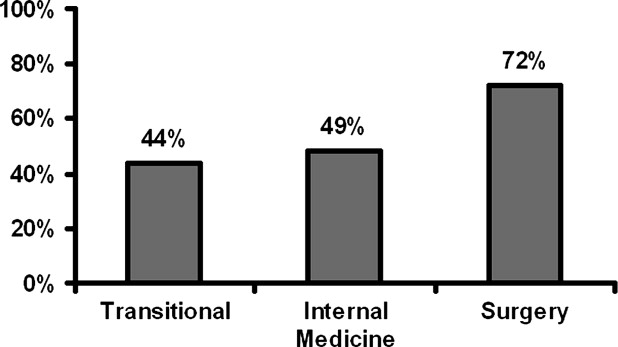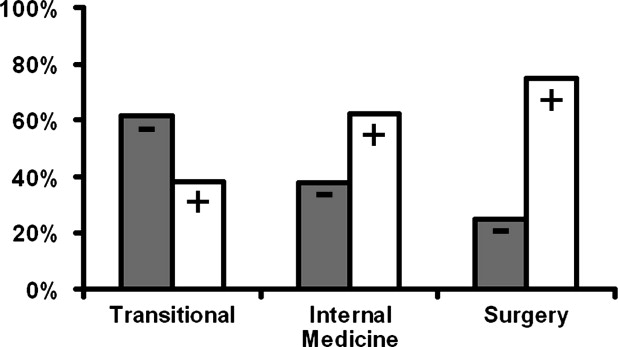Rationale and Objectives
The purpose of the study is to determine if transitional year program (TYP) requirements foster realization of standards of excellence and clinical relevance for future radiologists and to explore demographic and economic factors pertinent to TYPs.
Materials and Methods
A list of accredited TYPs were obtained from the American Medical Association’s Graduate Medical Education (ACGME) Directory 2006–2007. Specialty distribution of TYP graduates was examined from statistics provided by the ACGME, and data from the 2007 Main Residency Match was analyzed. Data derived from a concurrent survey of the perception of the value of internship sent to all current radiology residents and fellows was assessed. The institutional costs of employing TYP interns versus physician assistants were also calculated.
Results
Forty-one of the 125 TYPs lack residencies in internal medicine (IM), general surgery (GS), or both, and approximately two-third of these lack full medical school affiliation. The interns who will graduate from these 41 programs account for 103 of the 1,128 radiology residents in their post-graduate year 2. Despite the longest elective time offered in TYPs compared to conventional preliminary programs, current radiology trainees who had participated in preliminary IM or GS internships were more satisfied compared to trainees completing TYPs.
Conclusions
The requirements of the transitional internship and compliance with them need to be carefully assessed to determine their efficacy. Despite the strong economic impetus for hiring TYP interns, the availability of open slots in existing preliminary programs in IM and GS, coupled with radiology residents’ greater level of satisfaction with traditional over transitional internships, makes the existence of TYPs less compelling.
Medical school graduates seeking to enter specialties distinct from primary care must complete a mandated internship prior to joining their residency of choice. A majority of these residents match in preliminary programs in internal medicine (IM) and general surgery (GS) with a small minority pursuing pediatric internships. Since its inception in 1982, the transitional year internship has also become a popular alternative option for medical graduates for postgraduate year (PGY)-1 training ( ). Differences between conventional internships and transitional year programs (TYPs) involve organizational structure, opportunities for electives, and evaluation and oversight. Transitional internships are multidisciplinary, whereas conventional internships are predominantly confined within one specialty. Furthermore, TYP requirements allow for residents to take up to 8 weeks of electives in nonclinical patient care experiences, eg, research, administration, and computer science, which is generally not offered in conventional internships. TYPs afford a common pathway for subsequent training in many medical disciplines. Specific requirements are in large measure independent of the requirements of specialty board certification. To a greater extent than preliminary programs, TYPs take place in community hospitals, many of which do not have a close relationship with a medical school or university-based health center.
TYP positions are sought by medical school graduates who aspire to seek a residency in a wide array of specialties. Among all such trainees, prospective radiologists comprise the largest share ( ). The putative value of transitional year preparation for radiologists is that it is designed to provide a diverse clinical experience across an array of diseases which residents may expect to encounter later as diagnosticians. Hence, an optimal curriculum should include ward-based and outpatient experiences in both IM and GS. To this end, the Transitional Year Residency Review Committee (TYRRC), an arm of the Accreditation Council of Graduate Medical Education (ACGME), has enumerated extensive requirements to accommodate the opportunity for broad clinical exposure. In that regard, some of the distinctive features of transitional year regulations are:
Get Radiology Tree app to read full this article<
Get Radiology Tree app to read full this article<
Get Radiology Tree app to read full this article<
Get Radiology Tree app to read full this article<
Get Radiology Tree app to read full this article<
Get Radiology Tree app to read full this article<
Methods
Get Radiology Tree app to read full this article<
Get Radiology Tree app to read full this article<
Get Radiology Tree app to read full this article<
Get Radiology Tree app to read full this article<
Get Radiology Tree app to read full this article<
Results
Get Radiology Tree app to read full this article<
Table 1
Specialties Entered by Graduates of Transitional Year Programs, Academic Year 2006–2007
Specialty Percent Diagnostic Radiology 26.6 Anesthesiology 17.1 Ophthalmology 13.3 Dermatology 5.7 Physical Medicine and Rehabilitation 3.9 Emergency Medicine 3.8 Radiation Oncology 3.2
A plurality of transitional year program graduates joined diagnostic radiology residencies.
Get Radiology Tree app to read full this article<
Get Radiology Tree app to read full this article<
Table 2
Transitional Year Programs without Adequate Core Residencies and/or Medical School Affiliation
No. of Programs No. of Positions Not Affiliated/ Limited Affiliation Total TYPs 125 1,245 TYPs with endogenous residencies inc IM only 25 238 68% GS only 3 26 33% Neither 13 129 69% Subtotal 41 393 66%
Of the 125 transitional year programs (TYPs), 41 programs lack endogenous residencies in either internal medicine (IM), general surgery (GS), or both. Of these 41 TYPs, 27 (66%) are not affiliated or have a limited affiliation with a medical school. A total of 389 intern positions are available within these 41 programs, with an estimated 103 specializing in radiology. These 103 residents represent approximately 9% of the 1,128 radiology residents in their post-graduate (PGY)-2 year.
Get Radiology Tree app to read full this article<
Get Radiology Tree app to read full this article<
Get Radiology Tree app to read full this article<
Get Radiology Tree app to read full this article<
Table 3
National Resident Matching Program (NRMP) Match Results for 2007
No. of Positions No. of Filled U.S. Medical Graduates Foreign Medical Graduates Potential Positions GS-Prelim 1262 781 481 300 781 IM 4798 4720 2680 2040 2118 IM-Prelim 1885 1749 1491 258 394
A large number of positions in general surgery (GS) and internal medicine (IM) preliminary and categorical programs were unmatched or filled by foreign medical graduates during the 2007 match. The preliminary internship slots remaining unfilled by U.S. medical graduates outnumbered the 300 transitional year program (TYP) interns joining radiology residencies.
Get Radiology Tree app to read full this article<
Get Radiology Tree app to read full this article<
Table 4
Economic Benefit of Employing Transitional Year Program (TYP) Interns Versus Physician Assistants (PAs)
Physician Assistant Intern Base Salary $86,214 $49,746 Fringe Benefits $19,829 $11,442 One Primary Caregiver (FTE) 1.3 2.0 Hours worked/week 44 70 PA:Intern Ratio with Normalized Work Hours 1.6 1.0 FTE PA:Intern Ratio with Normalized Work Hours 2.1 1.0 Total Cost $219,317 $122,375 Medicare Contribution $0 $122,375 Cost to Institution $219,317 $0
One primary caregiver, computed as one full-time equivalent (FTE), normalized for equivalent work hours is equal to either two interns or 2.1 PAs. The institutional expenditure for salary and fringe benefits for 2.1 PAs is $219,317 and for 2.0 TYP interns is $122,375. However, if TYP intern positions are within the cap set by Medicare, salaries and fringe benefits for TYP interns may be fully reimbursed.
Get Radiology Tree app to read full this article<
Discussion
Get Radiology Tree app to read full this article<
Get Radiology Tree app to read full this article<
Get Radiology Tree app to read full this article<
Get Radiology Tree app to read full this article<
Get Radiology Tree app to read full this article<
Get Radiology Tree app to read full this article<
Get Radiology Tree app to read full this article<
Get Radiology Tree app to read full this article<
Get Radiology Tree app to read full this article<
References
1. Tupper R.L.: Transitional versus preliminary first-year programs. Hosp Phys 1987; pp. 19-25.
2. Accreditation Council of Graduate Medical Education: Specialties Entered by Graduates of Transitional Year Programs, Academic Year: 2006–2007.2007.Accreditation Council of Graduate Medical EducationChicago, IL
3. Accreditation Council of Graduate Medical Education: ACGME Program Requirements for Graduate Medical Education in the Transitional Year.2007.Accreditation Council of Graduate Medical EducationChicago, IL
4. 2006.American Medical AssociationChicago, IL
5. American College of Radiology: Current Resident Database.2007.American College of RadiologyReston, VA
6. Likert R.: A technique for the measurement of attitudes. Arch Psychol 1932; pp. 140.
7. National Resident Matching Program: NRMP Results and Data of 2007 Main Residency Match.2007.National Resident Matching ProgramWashington, DC
8. Tilak G.S., Baker Stephen R.: Self-subsidization of educational expenses by senior radiology residents. Acad Radiol 2007; 14: pp. 105-109.
9. American Academy of Physician Assistants: Summary measures of total annual income from primary employer for respondents who worked at least 32 hours per week at primary clinical job. http://www.aapa.org/research/07census-content.html November 5, 2007
10. American Academy of Physician Assistants: Summary measures of total hours worked per week for primary clinical employer by respondents who worked at least 32 hours per week at primary clinical job. http://www.aapa.org/research/07census-content.html
11. Amis S.E.: New program requirements for diagnostic radiology: Updated discussion on more complex requirements. AJR Am J Roentgenol 2007; pp. 2-4.
12. Accreditation Council of Graduate Medical Education: Does radiology training in the PGY-1 clinical year count toward the required 12-months of training toward in-house call?.Frequently Asked Questions, #43.2007.Accreditation Council of Graduate Medical EducationChicago, IL:
13. Sharma M.: Restructuring of anesthesiology residency training. American Society of Anesthesiologists, ASA Newsletter 2003; 67 http://www.asahq.org/Newsletters/2003/04_03/resReview04_03.html Accessed November 5, 2007

